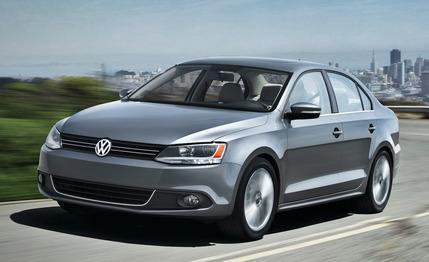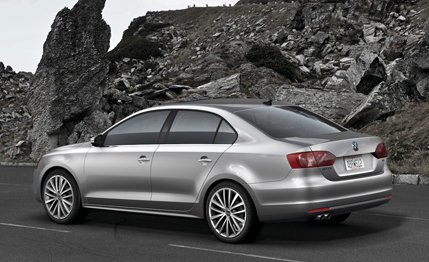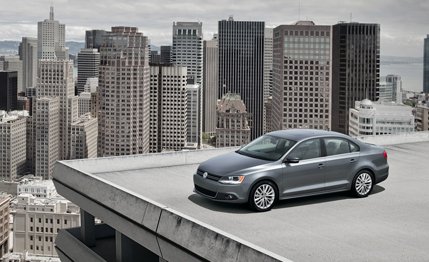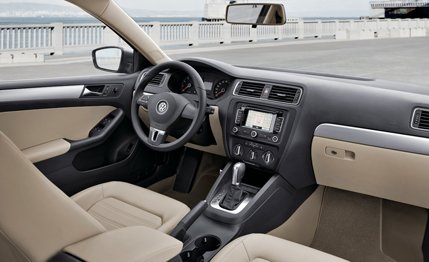
 First Drive Review
First Drive Review
During the press launch of the outgoing Jetta back in 2005, Volkswagen touted that car as a less expensive alternative to an Acura TSX or Volvo S40. Volkswagen pointed to its growth in size, high-quality interior, new rear suspension, and refined demeanor as evidence that the Jetta had moved out of the Honda Civic and Toyota Corolla class. Now take that script and reverse it. In introducing this car, the all-new 2011 Jetta, Volkswagen made it clear that the targets are once again the strong-selling Civic and Corolla. To entice folks considering those cars to also look at the Jetta, VW has lowered the model’s price, introduced a 115-hp base version, reduced the complexity of the options and trim levels, and grown it even further.
But there’s no such thing as a free lunch, and that means the 2011 Jetta has had to make some concessions. One very obvious compromise can be seen its dashboard material. Whereas the previous car had soft-touch, nicely grained plastics that were comparable to those of the Mercedes-Benz E-class, the new model has hard plastic that wouldn’t look too out of place in a Chrysler Sebring. The design itself is straightforward and handsome, but the hard plastic shines as if slathered with Armor All. Less obvious cost cutting includes the loss of adjustability for the center armrest, a lack of lumbar adjustment in most models, no more power-reclining seatbacks, and a simpler stability-control program that can no longer be shut off or even reduced. All models besides the top-spec GLI return to a torsion-beam solid rear axle, and the bottom two trim levels (S and SE) have rear drum brakes instead of discs. The news gets worse. Electric power steering is replaced by hydraulic power steering on non-GLI models, the hood no longer is held open by gas struts, and the compact gas-strut four-bar linkage that held open the previous Jetta’s trunk has been replaced by goose-neck-style hinges that intrude into the trunk compartment. Volkswagen clearly thinks the typical Civic or Corolla buyer won’t miss—or even notice—the lack of these items.


Hey, Look At the Pretty, Shiny Metal!
Volkswagen would, however, like shoppers to notice the Jetta’s new sheetmetal, which, ironically, is far less Corolla-esque than that of the previous generation. Slightly longer than before (by 2.9 inches), the new look signals that the Jetta is no longer just a Golf with a trunk. It’s far more polished and cohesive than the previous generation, especially when outfitted with the up-spec 17-inch wheels. There’s an expensive, almost Audi-like look to the Jetta, and that should sit well with VW loyalists and converts alike (well, so long as they stay outside).
Base Price Is Nice
But it’s the price that will really appeal to buyers cross-shopping the Corolla, the Civic, and the Jetta. At the bottom of the lineup is the Jetta S. Powered by an eight-valve 115-hp, 2.0-liter SOHC four-cylinder (yes, the same engine that powered the third-generation 1993 Jetta), the S starts at $16,755 and comes with a five-speed manual, air conditioning, power windows and mirrors, anti-lock brakes, cloth upholstery, stability control, remote keyless entry, 15-inch steel wheels, a 60/40 split-folding rear seat, free maintenance for three years or 36,000 miles, and an AM/FM/CD stereo with an auxiliary input. Volkswagen claims 0-to-60-mph acceleration times of 9.8 seconds for the five-speed manual and 11.0 seconds for the optional ($1100) six-speed automatic transmission. Fuel-economy estimates for the S engine are 24 mpg city and 34 mpg highway for the manual version and 23/32 for the automatic. VW didn’t have a base car available at the press launch, and we took that to mean the company wasn’t particularly proud of having a 17-year-old engine in its new car.
Moving up to the Jetta SE brings the familiar 170-hp, 2.5-liter five-cylinder found in the outgoing Jetta and current Golf. The more powerful engine does not affect fuel economy much, as the 2.5 achieves 23 mpg city and 33 mpg highway with the five-speed manual and 24/31 with the six-speed auto. In addition to the standard equipment from the Jetta S, the SE adds 16-inch steel wheels, vinyl seats that do a convincing impersonation of leather, floor mats, body-colored outside mirrors with turn signals, cruise control, illuminated vanity mirrors, chrome interior trim, and a rear center armrest. The SE starts at $18,955, and Volkswagen predicts it will be the bestselling version of the new Jetta. Add the Convenience package to the SE ($1350), and you get 16-inch aluminum wheels, Sirius satellite radio, two extra speakers for the stereo, iPod connectivity, heated seats, Bluetooth, and a leather-wrapped steering wheel with radio controls. Drop another $1250 on an SE, and besides the Convenience pack goodies, you get a sunroof and a touchscreen stereo head unit with a built-in six-disc changer and SD card reader.


Until the sporty GLI arrives in early 2011, the top Jetta will be the SEL. Starting at $22,155, the SEL adds the following to the SE with the Convenience package: 17-inch aluminum wheels, a touchscreen navigation system, chrome exterior trim, fog lights, four-wheel disc brakes, and proximity-based keyless entry and start. Adding a sunroof to the SEL costs $900. And finally, something for enthusiasts: The SEL is available with a Sport package that includes stiffer suspension tuning, sport seats, and aluminum pedals. An SEL with the Sport package—it includes the sunroof—starts at $23,755.
Wanna Go Diesel? You’ll Have to Wait.
The Jetta S, SE, and SEL go on sale in early October. The TDI won’t arrive until the end of the year. Powered by the same 2.0-liter turbo-diesel four-cylinder it had last year, the $23,755 TDI will carry all the equipment of the top-spec SE plus rear disc brakes. The diesel makes 140 hp and 236 lb-ft of torque that, according to VW, is good for a 0-to-60 sprint of 8.7 seconds with a six-speed manual or the six-speed dual-clutch gearbox (an $1100 option). But what diesel buyers will perhaps be more interested in is the TDI’s fuel economy, which comes in at an EPA-estimated 30 mpg city and 42 mpg highway.


Still Good to Drive, Despite the Cost Cutting
After driving an SEL with a sunroof and an SEL with the Sport package, we can say that we don’t really miss the multilink rear suspension. Although the cost cutting is readily apparent in the simplified mechanicals and interior appointments, the driving experience is nearly identical to that of the outgoing model. Even without the sportier suspension, the chassis is tautly damped and responsive to driver inputs. Although the switch from electrically boosted steering to a hydraulic system didn’t improve the slightly numb on-center feel, the steering effort of the hydraulic unit builds in a more linear manner in response to cornering loads. The slightly firmer and lower Sport-package suspension is a bit more harsh and finds the bump stops more readily than the base setup, but it does offer slightly quicker responses and more roll resistance. The manual gearbox shifts easily, but it has very tall gearing in the top two gears, necessitating the occasional downshift into third to find any meaningful acceleration. The optional six-speed automatic is eager to shift into the upper gears in the interest of fuel economy, but it downshifts without hesitation. The autobox again features a sport mode that holds the lower gears longer; manual gearshifts can be actuated via the shift lever. Wind, road, and engine noise are muted, and the car—at least in SEL guise, like those we drove—has a more upmarket feel than its smaller Japanese competition. Plus, the Jetta’s rear seat is far roomier than the Civic’s or Corolla’s and is closer to cars in the mid-size-sedan segment. We’d still like to experience the SE or the base S, which compete more directly with the Civic and Corolla, to see if the impression of refinement holds up.
Volkswagen has big plans to grow its stateside sales, and it hopes to sell 800,000 VW-badged cars in the U.S. in 2018. That is, as you might expect, very ambitious, especially considering VW sold roughly a quarter of that number here in 2009. The company is clearly targeting the mainstream buyer with the 2011 Jetta, so we’re glad to see that the competent, Germanic driving dynamics have remained intact despite the obvious cost cutting. Of course, if the cutbacks to the new Jetta bother you, VW will happily sell you a Golf or even a Jetta SportWagen (the wagon is still based on the previous generation). Those cars haven’t been decontented—at least not yet.